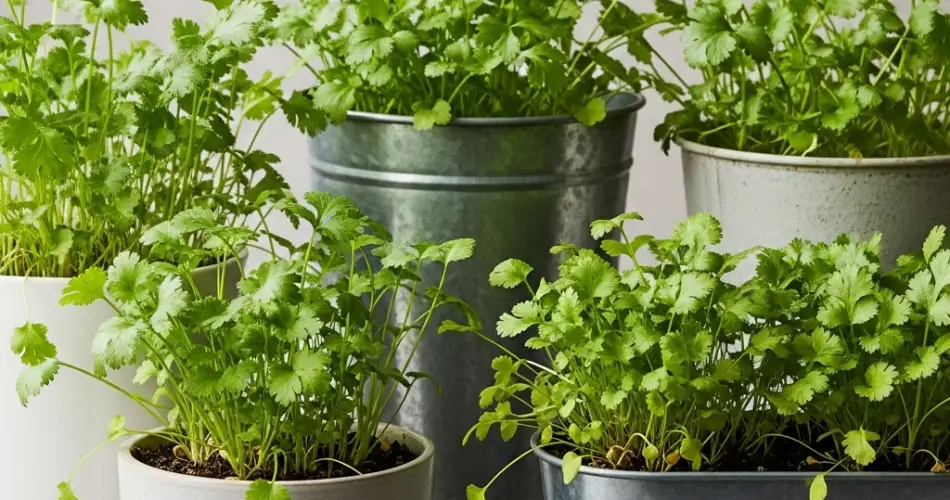Cilantro, also known as coriander in many regions, is a fast-growing herb that adds a fresh, zesty flavor to a variety of dishes—from salsa and chutneys to soups, curries, and salads. Growing cilantro in containers is not only easy but also incredibly rewarding. Whether you’re a seasoned gardener or just starting out, container gardening allows you to enjoy this flavorful herb even with limited space.
With the right setup, a bit of sunlight, and consistent care, you can grow fresh cilantro year-round on a balcony, windowsill, or patio. Here’s a complete guide on how to sow, grow, and harvest cilantro in pots.
Why Grow Cilantro in Containers?
Cilantro tends to bolt (flower and go to seed) quickly in warm weather. By growing it in containers, you have more control over the environment and can easily move the pot to a cooler or shadier location if needed.
Container gardening also offers these advantages:
-
Maximizes space in small homes and apartments
-
Makes pest management easier
-
Allows for quick replanting and crop rotation
-
Keeps the herb closer to your kitchen for convenient harvesting
Choosing the Right Pot
Cilantro grows a long taproot, so it prefers deep pots over wide, shallow ones. Select a container that is:
-
At least 8–10 inches deep
-
12 inches wide or more to accommodate multiple plants
-
Equipped with good drainage holes
You can use clay, ceramic, plastic, or even fabric grow bags. Just make sure the pot drains well to avoid soggy roots.
Best Soil for Cilantro
Cilantro thrives in well-draining, nutrient-rich soil. A quality potting mix that includes compost is ideal. You can also create a custom mix using:
-
2 parts all-purpose potting soil
-
1 part compost for nutrients
-
1 part perlite or coarse sand for drainage
Avoid heavy soils that retain too much moisture. Cilantro prefers slightly moist soil but doesn’t tolerate waterlogged conditions.
How to Sow Cilantro Seeds in Containers
Cilantro grows best when directly sown from seed, as it doesn’t like to be transplanted due to its taproot.
Steps to sow cilantro in containers:
-
Fill your pot with moistened soil, leaving about 1 inch from the rim.
-
Scatter the seeds evenly over the surface.
-
Cover with a thin layer of soil, about ¼ inch deep.
-
Mist the soil gently to avoid disturbing the seeds.
-
Place the pot in a sunny spot that receives at least 4–6 hours of light daily.
Seeds usually germinate in 7 to 10 days. Once seedlings reach 2 inches tall, thin them out, leaving about 3–4 inches between plants for airflow and growth.
Light and Temperature
Cilantro prefers cooler weather and does best in temperatures between 50°F and 75°F (10°C to 24°C). It enjoys full sun but will benefit from some afternoon shade in hot climates to prevent premature bolting.
If you’re growing cilantro indoors, place the container near a bright window or under a grow light. Rotate the pot every few days to encourage even growth.
Watering and Fertilizing
Cilantro likes moist but not soggy soil. Water regularly to keep the top inch of soil consistently damp, especially during dry or hot weather. Always check that the pot drains freely and doesn’t retain excess moisture.
As for feeding, cilantro doesn’t need heavy fertilization. A diluted liquid fertilizer or compost tea every 3–4 weeks during the growing season is sufficient. Over-fertilizing can lead to lush foliage with weaker flavor.
Pruning and Harvesting
Begin harvesting cilantro when the plant is about 6 inches tall. Snip outer leaves first, leaving the inner ones to continue growing. Use clean scissors or pinch off leaves by hand.
To encourage bushier growth:
-
Harvest regularly by trimming the tops
-
Avoid taking more than one-third of the plant at a time
-
Remove flower stalks as soon as they appear to delay bolting
Cilantro grows quickly, so for a continuous supply, consider sowing a new batch every 2 to 3 weeks.
Managing Bolting and Extending the Harvest
Bolting is when the plant starts to flower and produce seeds, often triggered by heat or irregular watering. Once cilantro bolts, the leaves become bitter and less desirable for culinary use.
Tips to reduce bolting:
-
Provide afternoon shade during hot months
-
Water consistently to prevent stress
-
Harvest frequently to delay flowering
If bolting occurs, allow the flowers to mature and produce seeds. These seeds are known as coriander and can be collected, dried, and used in cooking or saved for future planting.
Saving Seeds (Coriander)
To collect seeds:
-
Allow the plant to flower and form seed heads.
-
When the heads dry and turn brown, cut them and place them in a paper bag.
-
Shake the bag to release the seeds.
-
Store seeds in a cool, dry place in an airtight container.
These seeds can be ground into coriander spice or planted to grow new cilantro plants.
Final Thoughts
Cilantro is a quick, satisfying herb to grow in containers. With proper soil, light, and care, you can enjoy fresh, fragrant leaves for your favorite recipes in just a few weeks. While its growing cycle is short, succession planting and proper maintenance can ensure a near-continuous harvest throughout the season.
Whether placed on a sunny balcony, kitchen windowsill, or patio table, a pot of cilantro is a practical and flavorful addition to any home garden.



